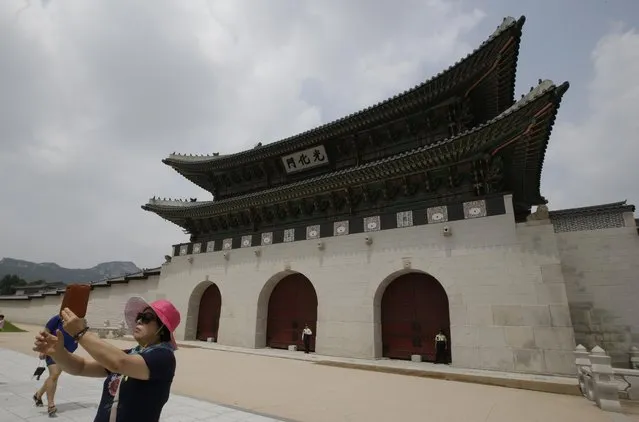
A woman takes a selfie near the Gwanghwamun, the main gate of the 14th-century Gyeongbok Palace and also one of South Korea's well known landmarks in Seoul, South Korea, Tuesday, July 28, 2015. (Photo by Lee Jin-man/AP Photo)
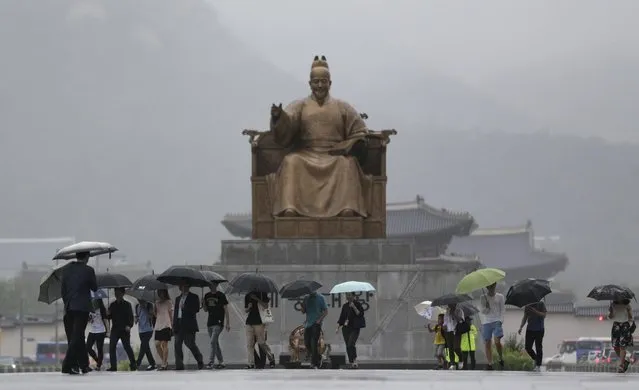
People hold umbrellas against the rain near the statue of the Chosun Dynasty's King Sejong, which has a height of 6.2 meter and weighs 20 ton, in downtown Seoul, South Korea, Monday, July 13, 2015. (Photo by Lee Jin-man/AP Photo)
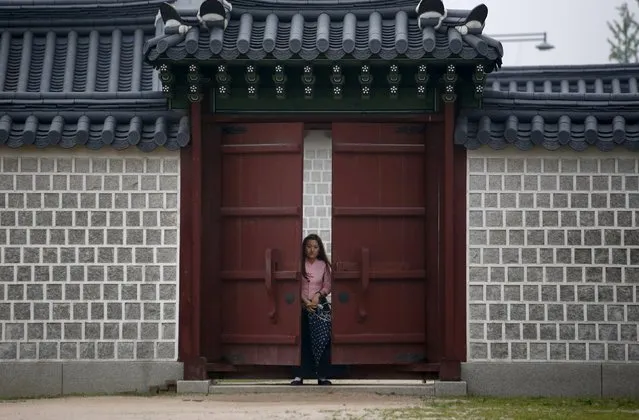
An employee in traditional costume stands behind a locked gate at Gyeongbok Palace in central Seoul, South Korea, July 13, 2015. (Photo by Kim Hong-Ji/Reuters)
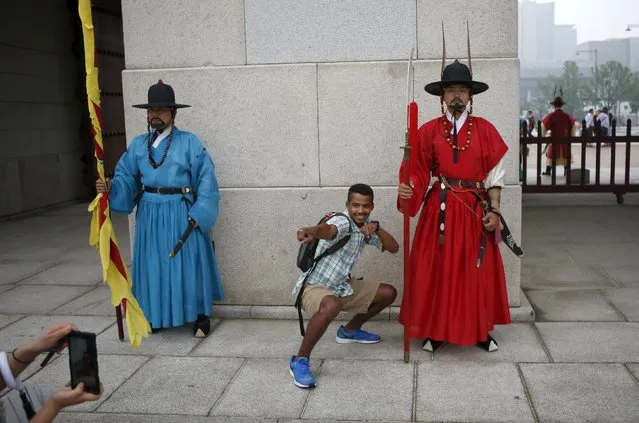
A tourist poses for photographs next to workers wearing traditional dress while attending the daily re-enactment of the changing of the Royal Guards at Gyeongbok Palace in central Seoul, South Korea, July 13, 2015. (Photo by Kim Hong-Ji/Reuters)

Youths pose for photographs at Bukchon Hanok Village, a traditional village in Seoul, South Korea, July 13, 2015. (Photo by Kim Hong-Ji/Reuters)
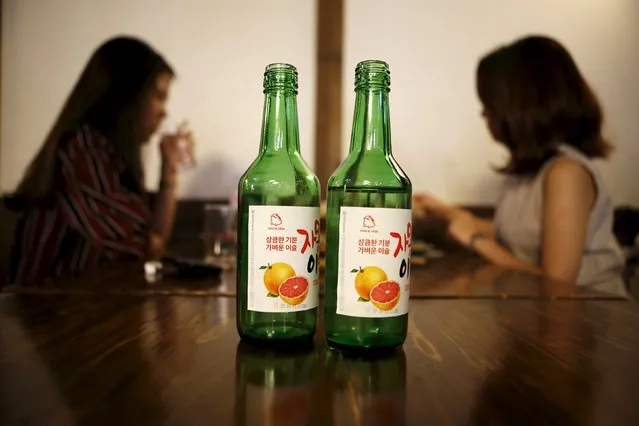
Bottles of fruit flavoured and low-alcohol soju are seen in this picture illustration at a pub in Seoul, South Korea, September 9, 2015. Professional women are driving a change in the way beverage companies look at South Korea, which hard-drinking men have made Asia's biggest alcohol consuming country on a per capita basis. As more women join the workforce in South Korea, a growing share of younger women are becoming regular drinkers, shifting consumption patterns in a male-dominated society where post-work drinking sessions are a staple of office life. Rising incomes and a greater interest in health also mean fewer Koreans merely seek out the cheapest way to get drunk. (Photo by Kim Hong-Ji/Reuters)
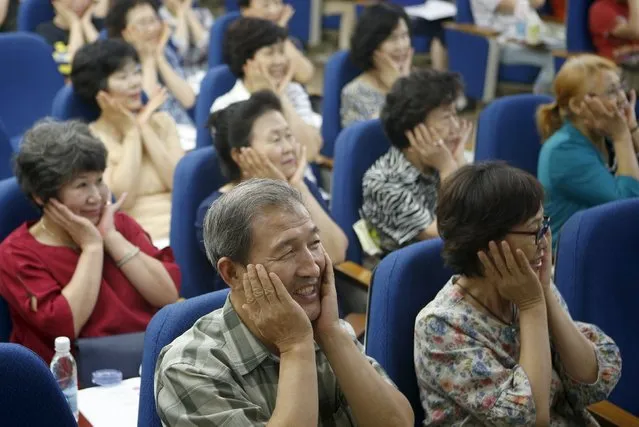
Grandparents take part in a child care class for them in Seoul, South Korea, September 1, 2015. It is not unusual for South Koreans to pay their parents to take care of their children. But the number doing so is on the rise and the arrangement has become more professional-like as parents increasingly pay the equivalent of full babysitting rates. Childcare classes for the elderly, rare before 2013, have cropped up at public health centres. The trend is being driven by changes in South Korea's population – the fastest-ageing in the world. (Photo by Kim Hong-Ji/Reuters)
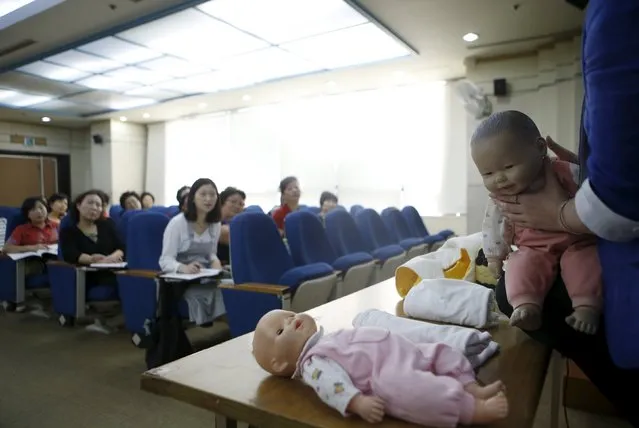
An instructor gives a lecture during a child care class for grandparents in Seoul, South Korea, September 1, 2015. (Photo by Kim Hong-Ji/Reuters)
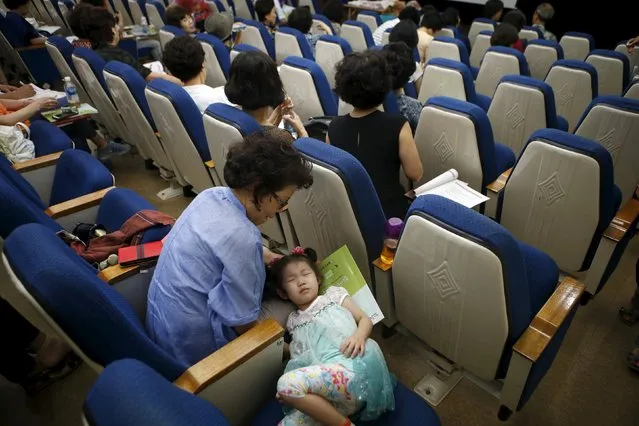
A girl takes a nap next to her grandmother during a child care class for grandparents in Seoul, South Korea, September 1, 2015. (Photo by Kim Hong-Ji/Reuters)

Visitors rest in the shade in the midday heat at Cheonggye stream in Seoul, South Korea, Tuesday, July 28, 2015. (Photo by Lee Jin-man/AP Photo)

A woman wearing a mask to prevent contracting MERS walks out from a clothing shop at Myeongdong shopping district in central Seoul, South Korea, June 11, 2015. (Photo by Kim Hong-Ji/Reuters)
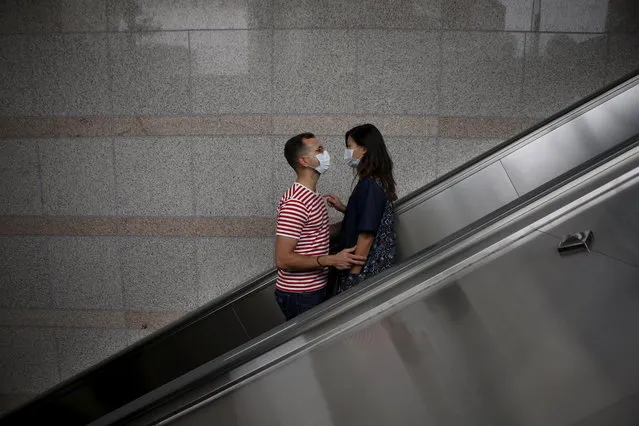
A couple wearing masks to prevent contracting MERS looks at each other as they ride on an escalator in Seoul, South Korea, June 11, 2015. (Photo by Kim Hong-Ji/Reuters)
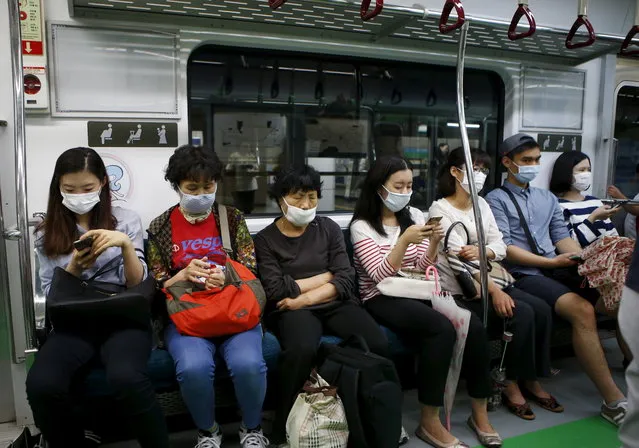
Passengers wearing masks to prevent contracting MERS sit inside a train in Seoul, South Korea, June 5, 2015. (Photo by Kim Hong-Ji/Reuters)
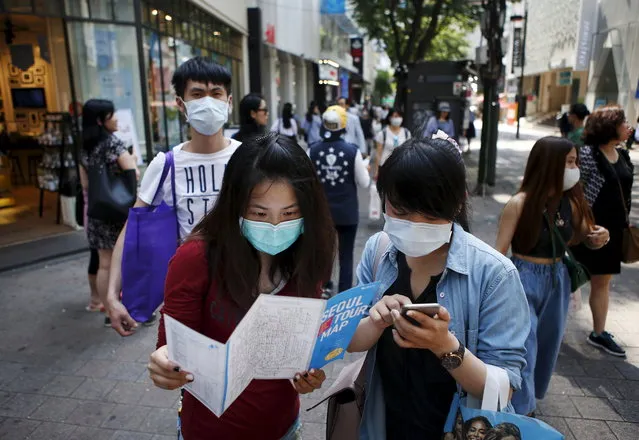
Tourists wearing masks to prevent contracting MERS look at a tour map of Seoul at Myeongdong shopping district, in central Seoul, South Korea, June 10, 2015. (Photo by Kim Hong-Ji/Reuters)
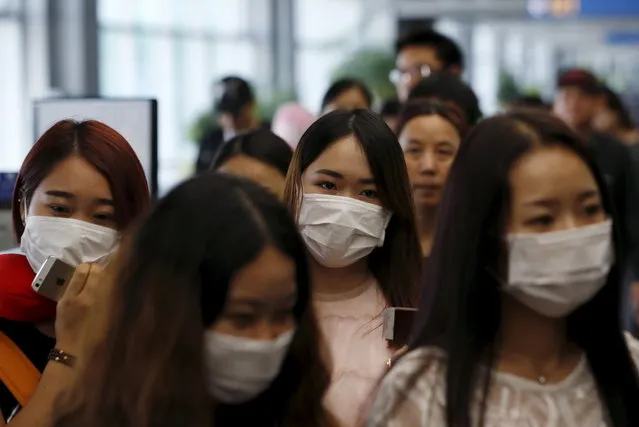
Passengers wearing masks to prevent contracting MERS walk past a thermal imaging camera (unseen) at Incheon International Airport in Incheon, South Korea, June 2, 2015. (Photo by Kim Hong-Ji/Reuters)

Cheonggyecheon, the stream runs through the center of Seoul is seen on July 29, 2015 in Seoul, South Korea. The stream was named Gaecheon which means open stream and constructed as a drainage system during the Joseon Dynasty (A.D. 1392-1910). Gaecheon was renamed to the current name Cheonggyecheon which means clean open stream during the Japanese imperial colonial period. After the Korean War, more people migrated into Seoul and settled down along the stream. As a result it caused public hygiene issue, so the government decide to cover up the stream with concrete over 20 years starting in 1958 and a 5.6Km long, 16m-wide elevated a high level road was completed in 1976. In 2005, the stream was restored under the Cheonggyecheon Restoration Project initiated by then-Seoul mayor Lee Myung-Bak who is former president of South Korea. (Photo by Shin Woong-jae/The Washington Post)
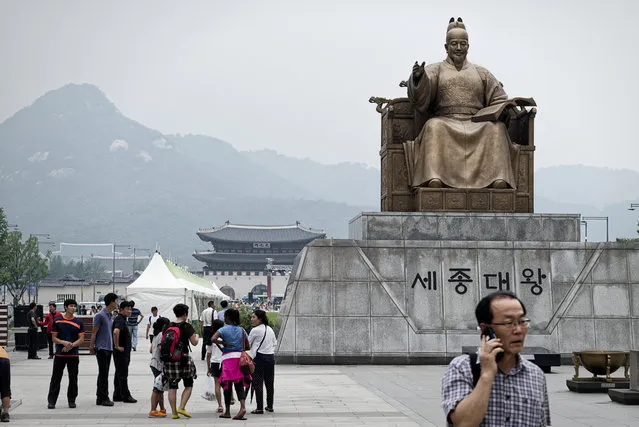
The statue of Sejong the Great is seen at Gwanghwamun Square, and behind the statue, Bugaksan Mountain, Cheongwadae the Presidential Mansion and Gwanghwamun are seen on July 29, 2015 in Seoul, South Korea. Sejong the Great (May 15, 1397-April 8, 1450, r. 1418-1459) was the fourth king of Joseon Dynasty, and one of his many achievement is the creation and introduction of Hangul, the native alphabet system for the Korean language. Seeding is one of only two Korean rulers honored as “the Great”, and the other one is Gwanggaeto the Great of Goguryeo (374-413, r. 391-413). (Photo by Shin Woong-jae/The Washington Post)
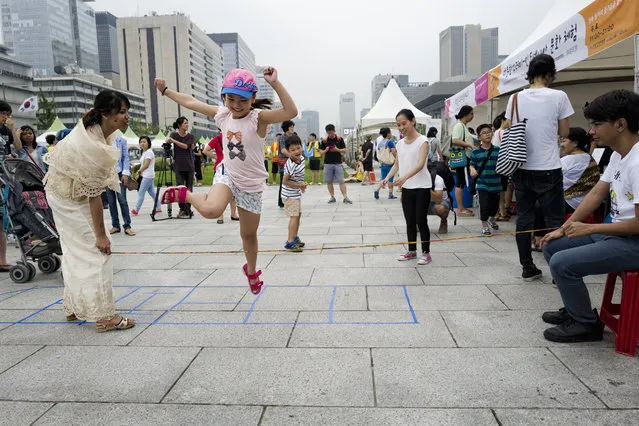
Kids plays Philippine traditional game with a elastic string at a temporal cultural experience zone on Gwanghwamun Square on July 29, 2015 in Seoul, South Korea. (Photo by Shin Woong-jae/The Washington Post)
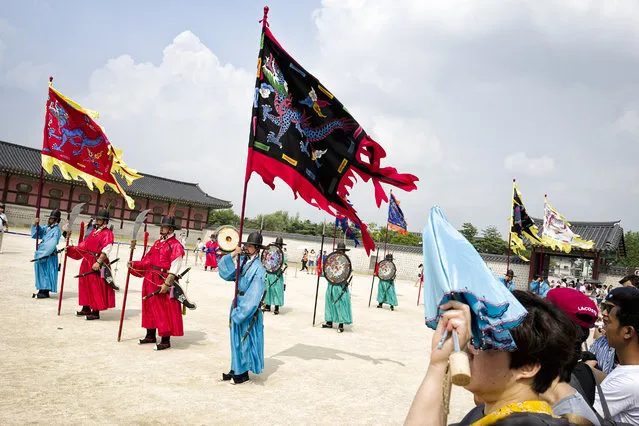
Tourist watch Changing Sumunjang, the royal palace gate guard at Gyungbokgung Palace on August 1, 2015 in Seoul, South Korea. Gyungbokgung is the royal palace of Joseon Dynasty which was constructed in 1395. “Gyungbok” means “praying for the King, King's family and the nation” and “gung” means “a palace”. (Photo by Shin Woong-jae/The Washington Post)
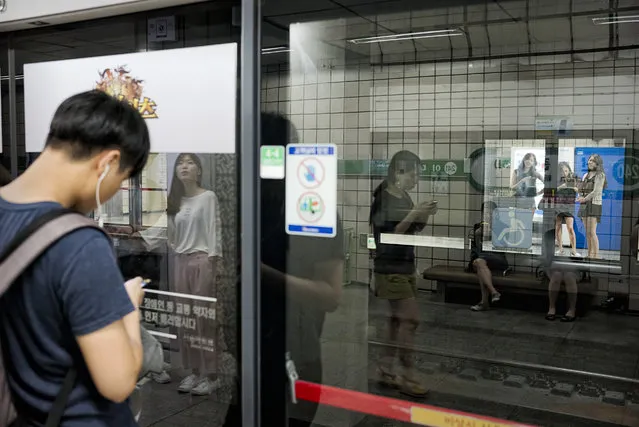
People wait for a subway train at a platform of Sinchon station on August 4, 2015 in Seoul, South Korea. An automated screen doors with advertisements and signs are installed in most of subway station in Seoul. (Photo by Shin Woong-jae/The Washington Post)
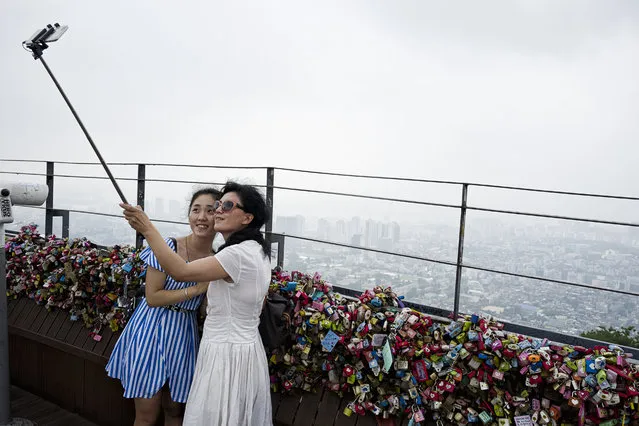
Tourists take selfie with a selfie stick at the observation deck at N Seoul Tower on the top of Namsan mountain on July 29, 2015 in Seoul, South Korea. Thousands of key locks are locked fences as souvenirs or symbol of love by visitors. (Photo by Shin Woong-jae/The Washington Post)

People have chats drinking soju (Korean gin) and makgeolli (Korean rice wine) at open tables by restaurants on a street at Jongno-gu on August 1, 2015 in Seoul, South Korea. (Photo by Shin Woong-jae/The Washington Post)
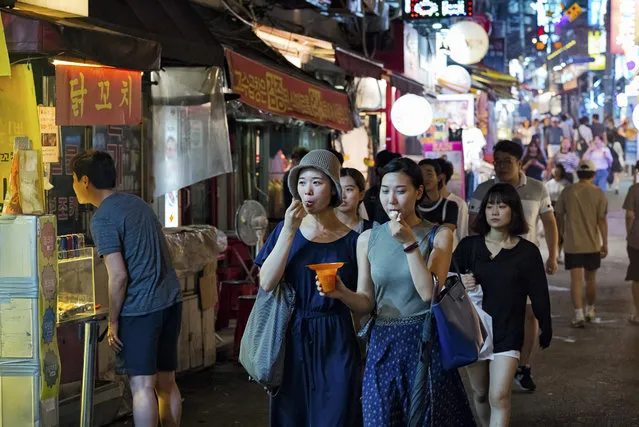
Young people walk an alley in Hongdae area on July 29, 2015 in Seoul, South Korea. The Hongdae area is a region around Hongik University in Seoul, South Korea. Hongdae is an abbreviation of 'Hong'ik 'Dae'hakyo, Hongik University. Hongdae is know for entertainment, food and beverage, arts, shopping and clubs for indie music to dance floor for South Korean youngsters. (Photo by Shin Woong-jae/The Washington Post)
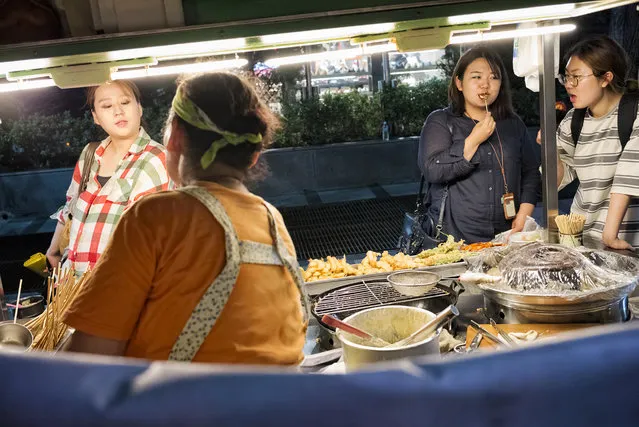
People enjoy street food at a food cart near Sinchon subway station on August 4, 2015 in Seoul, South Korea. (Photo by Shin Woong-jae/The Washington Post)
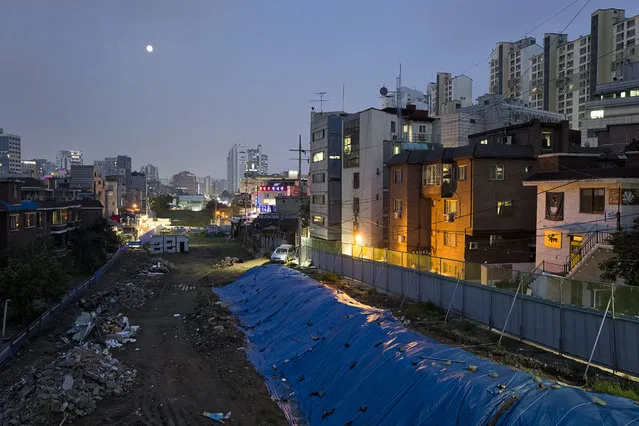
Full moon is seen over an old train track site in Hongdae area on July 30, 2015 in Seoul, South Korea. The old train track was the part of Gyeongui Line which connects Seoul and Incheon, and the site will be transformed to a public park by local government. The view is from Wawoo bridge. The Hongdae area is a region around Hongik University in Seoul, South Korea. Hongdae is an abbreviation of 'Hong'ik 'Dae'hakyo, Hongik University. Hongdae is know for entertainment, food and beverage, arts, shopping and clubs for indie music to dance floor for South Korean youngsters. (Photo by Shin Woong-jae/The Washington Post)

Monks hold evening chanting ceremony in The Mail Hall of Seonamsa Buddhist Temple on July 31, 2015 in Suncheon, Jeollanamdo Province, South Korea. The temple was founded in A.D. 529, and the name Seonam means “Heavenly Rock” or “Immortal's Rock”. The Main Hall of the temple is one of treasures of South Korea. (Photo by Shin Woong-jae/The Washington Post)
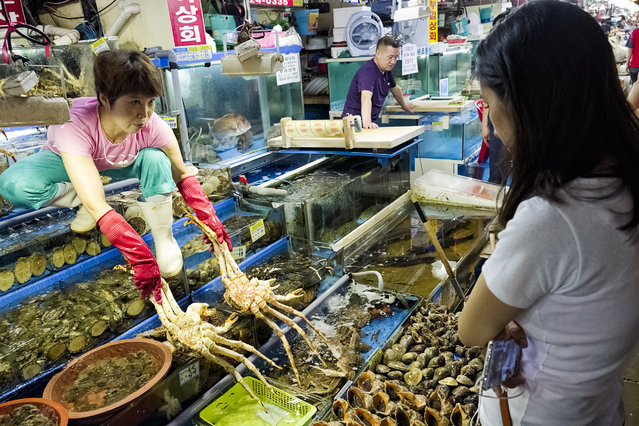
A sales woman of a fish shop shows king crabs to a customer and negotiates the price in Noryangjin Fish Market is seen on August 1, 2015 in Seoul, South Korea. Noryangjin Fish Market was established in 1927 as Gyeongseong Susan in Jung-gu near Seoul Station and moved to its current location in 1971. (Photo by Shin Woong-jae/The Washington Post)
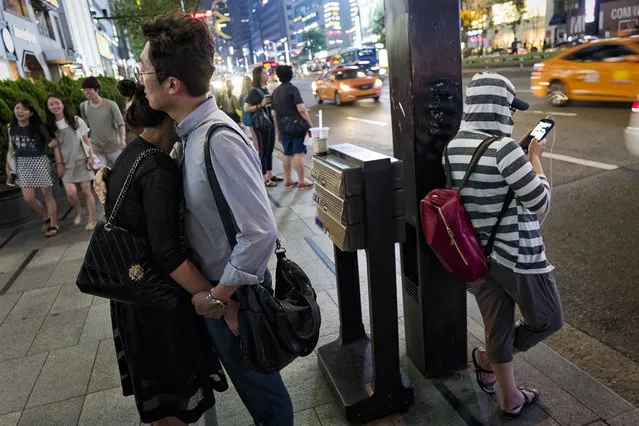
People are seen on a street of Gangnam station area on August 4, 2015 in Seoul, South Korea. A floating population of Gangnam station area is more than million per day. (Photo by Shin Woong-jae/The Washington Post)
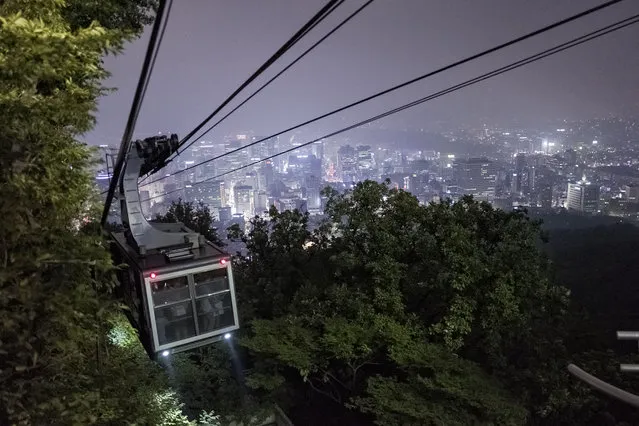
A cable car with passengers descends to ground from the top of Namsan mountain on July 30, 2015 in Seoul, South Korea. North side of the City of Seoul is seen down the mountain. (Photo by Shin Woong-jae/The Washington Post)
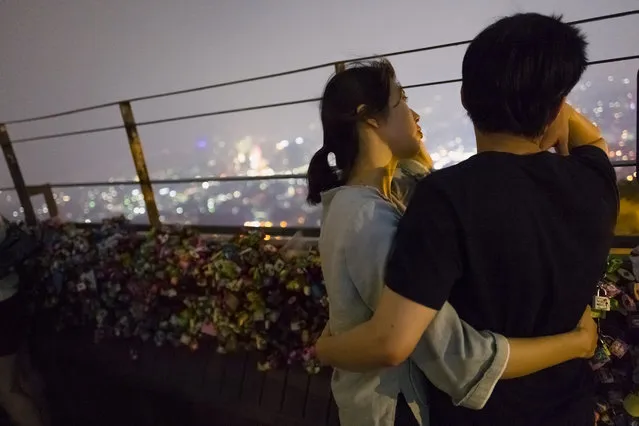
A couple have conversation while watching the night view of Seoul from the observation deck on the top of Namsan mountain on July 30, 2015 in Seoul, South Korea. (Photo by Shin Woong-jae/The Washington Post)
11 Sep 2015 12:21:00,
post received
0 comments
